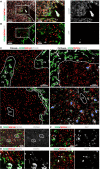Characteristics of SOX9-positive progenitor-like cells during cholestatic liver regeneration in biliary atresia
- PMID: 35313986
- PMCID: PMC8935712
- DOI: 10.1186/s13287-022-02795-2
Characteristics of SOX9-positive progenitor-like cells during cholestatic liver regeneration in biliary atresia
Abstract
Background: The progression of Biliary Atresia (BA) is associated with the number of reactive ductular cells (RDCs) whose heterogeneity in origin and evolution in humans remains unknown. SOX9-positive liver progenitor-like cells (LPLCs) have been shown to participate in RDCs and new hepatocyte formation during cholestatic liver regeneration in an animal model, which implies the possibility that hepatocyte-reprogrammed LPLCs could be a source of RDCs in BA. The present study aimed to elucidate the characteristics of SOX9-positive LPLCs in BA for exploring new possible therapeutic targets by manipulating the bi-differentiation process of LPLCs to prevent disease progression.
Methods: Twenty-eight patients, including 24 patients with BA and 4 patients with Congenital Choledochal Cyst as the control group, were retrospectively recruited. Liver biopsy samples were classified histologically using a 4-point scale based on fibrosis severity. LPLCs were detected by SOX9 and HNF4A double positive staining. Single immunohistochemistry, double immunohistochemistry, and multiple immunofluorescence staining were used to determine the different cell types and characteristics of LPLCs.
Results: The prognostic predictors of BA, namely total bile acid (TBA), RDCs, and fibrosis, were correlated to the emergence of LPLCs. SOX9 and HNF4A double-positive LPLCs co-stained rarely with relevant markers of portal hepatic progenitor cells (portal-HPCs), including CK19, CK7, EPCAM, PROM1 (CD133), TROP2, and AFP. Under cholestasis conditions, LPLCs acquired superior proliferation and anti-senescence ability among hepatocytes. Moreover, LPLCs arranged as a pseudo-rosette structure appeared from the periportal parenchyma to the portal region, which implied the differentiation from hepatocyte-reprogrammed LPLCs to RDCs with the progression of cholestasis.
Conclusions: LPLCs are associated with disease progression and prognostic factors of BA. The bipotent characteristics of LPLCs are different from those of portal-HPCs. As cholestasis progresses, LPLCs appear to gain superior proliferation and anti-senescence ability and continually differentiate to RDCs.
Keywords: Biliary atresia; Hepatic progenitor cells; Liver progenitor-like cells; Reactive ductular cells; SOX9.
© 2022. The Author(s).
Conflict of interest statement
The authors declare that they have no competing interests.
Figures




Similar articles
-
SOX9 in biliary atresia: New insight for fibrosis progression.Hepatobiliary Pancreat Dis Int. 2021 Apr;20(2):154-162. doi: 10.1016/j.hbpd.2020.12.007. Epub 2020 Dec 9. Hepatobiliary Pancreat Dis Int. 2021. PMID: 33349604
-
New insight into reactive ductular cells of biliary atresia provided by pathological assessment of SOX9.Pediatr Surg Int. 2014 May;30(5):481-92. doi: 10.1007/s00383-014-3497-7. Pediatr Surg Int. 2014. PMID: 24658905
-
Prominin-1-expressing hepatic progenitor cells induce fibrogenesis in murine cholestatic liver injury.Physiol Rep. 2020 Jul;8(14):e14508. doi: 10.14814/phy2.14508. Physiol Rep. 2020. PMID: 32686913 Free PMC article.
-
Development and molecular composition of the hepatic progenitor cell niche.Dan Med J. 2013 May;60(5):B4640. Dan Med J. 2013. PMID: 23673270 Review.
-
Liver Regeneration in Chronic Liver Injuries: Basic and Clinical Applications Focusing on Macrophages and Natural Killer Cells.Cell Mol Gastroenterol Hepatol. 2022;14(5):971-981. doi: 10.1016/j.jcmgh.2022.05.014. Epub 2022 Jun 20. Cell Mol Gastroenterol Hepatol. 2022. PMID: 35738473 Free PMC article. Review.
Cited by
-
Single-cell transcription reveals hepatocyte-to-cholangiocyte reprogramming and biliary gene profile in biliary atresia.Hepatol Commun. 2025 May 6;9(5):e0710. doi: 10.1097/HC9.0000000000000710. eCollection 2025 May 1. Hepatol Commun. 2025. PMID: 40366121 Free PMC article.
-
Multicomponent parenteral lipid emulsions do not prevent liver injury in neonatal pigs with obstructive cholestasis.JCI Insight. 2025 Apr 17;10(10):e189196. doi: 10.1172/jci.insight.189196. eCollection 2025 May 22. JCI Insight. 2025. PMID: 40244694 Free PMC article.
-
Decoding Cellular Stress States for Toxicology Using Single-Cell Transcriptomics.bioRxiv [Preprint]. 2025 Aug 2:2025.06.10.657506. doi: 10.1101/2025.06.10.657506. bioRxiv. 2025. PMID: 40766395 Free PMC article. Preprint.
-
Improvements in Maturity and Stability of 3D iPSC-Derived Hepatocyte-like Cell Cultures.Cells. 2023 Sep 27;12(19):2368. doi: 10.3390/cells12192368. Cells. 2023. PMID: 37830581 Free PMC article.
-
Hepatocyte differentiation requires anisotropic expansion of bile canaliculi.Development. 2024 Nov 15;151(22):dev202777. doi: 10.1242/dev.202777. Epub 2024 Nov 21. Development. 2024. PMID: 39373104 Free PMC article.
References
-
- Kasahara M, Umeshita K, Sakamoto S, Fukuda A, Furukawa H, Uemoto S. Liver transplantation for biliary atresia: a systematic review. Pediatr Surg Int. 2017;33(12):1289–1295. - PubMed
-
- Kim WR, Lake JR, Smith JM, Schladt DP, Skeans MA, Noreen SM, et al. OPTN/SRTR 2017 annual data report: liver. Am J Transplant. 2019;19(Suppl 2):184–283. - PubMed
-
- Elisofon SA, Magee JC, Ng VL, Horslen SP, Fioravanti V, Economides J, et al. Society of pediatric liver transplantation research group. Society of pediatric liver transplantation: current registry status 2011–2018. Pediatr Transplant. 2020;24(1):136. - PubMed
-
- Lampela H, Kosola S, Heikkilä P, Lohi J, Jalanko H, Pakarinen MP. Native liver histology after successful portoenterostomy in biliary atresia. J Clin Gastroenterol. 2014;48(8):721–728. - PubMed
Publication types
MeSH terms
Substances
LinkOut - more resources
Full Text Sources
Research Materials
Miscellaneous

